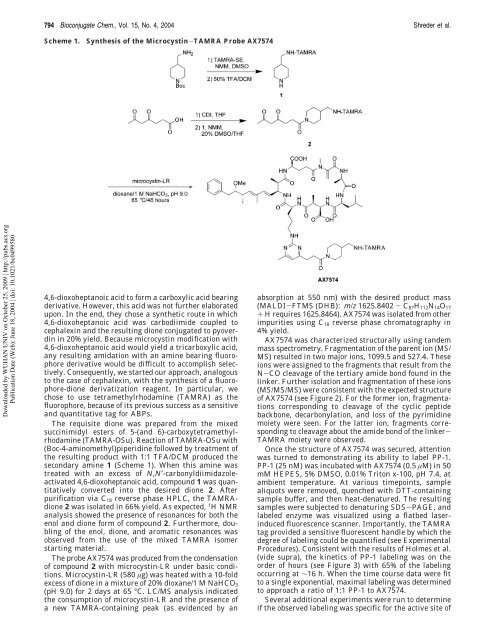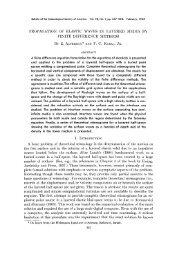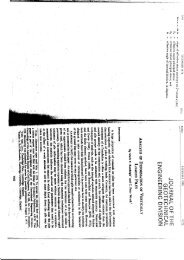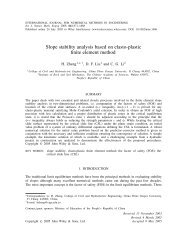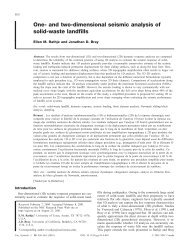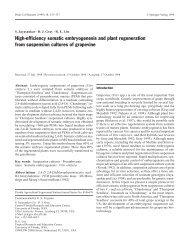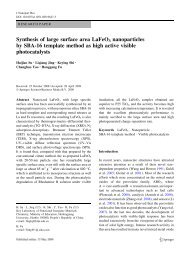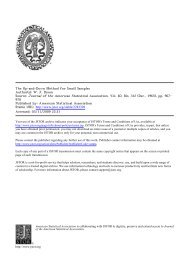Design and Synthesis of AX7574: A Microcystin-Derived ...
Design and Synthesis of AX7574: A Microcystin-Derived ...
Design and Synthesis of AX7574: A Microcystin-Derived ...
Create successful ePaper yourself
Turn your PDF publications into a flip-book with our unique Google optimized e-Paper software.
794 Bioconjugate Chem., Vol. 15, No. 4, 2004 Shreder et al.Scheme 1.<strong>Synthesis</strong> <strong>of</strong> the <strong>Microcystin</strong>-TAMRA Probe <strong>AX7574</strong>Downloaded by WUHAN UNIV on October 25, 2009 | http://pubs.acs.orgPublication Date (Web): June 18, 2004 | doi: 10.1021/bc04995804,6-dioxoheptanoic acid to form a carboxylic acid bearingderivative. However, this acid was not further elaboratedupon. In the end, they chose a synthetic route in which4,6-dioxoheptanoic acid was carbodiimide coupled tocephalexin <strong>and</strong> the resulting dione conjugated to pyoverdinin 20% yield. Because microcystin modification with4,6-dioxoheptanoic acid would yield a tricarboxylic acid,any resulting amidation with an amine bearing fluorophorederivative would be difficult to accomplish selectively.Consequently, we started our approach, analogousto the case <strong>of</strong> cephalexin, with the synthesis <strong>of</strong> a fluorophore-dionederivatization reagent. In particular, wechose to use tetramethylrhodamine (TAMRA) as thefluorophore, because <strong>of</strong> its previous success as a sensitive<strong>and</strong> quantitative tag for ABPs.The requisite dione was prepared from the mixedsuccinimidyl esters <strong>of</strong> 5-(<strong>and</strong> 6)-carboxytetramethylrhodamine(TAMRA-OSu). Reaction <strong>of</strong> TAMRA-OSu with(Boc-4-aminomethyl)piperidine followed by treatment <strong>of</strong>the resulting product with 1:1 TFA/DCM produced thesecondary amine 1 (Scheme 1). When this amine wastreated with an excess <strong>of</strong> N,N′-carbonyldiimidazoleactivated4,6-dioxoheptanoic acid, compound 1 was quantitativelyconverted into the desired dione 2. Afterpurification via C 18 reverse phase HPLC, the TAMRAdione2 was isolated in 66% yield. As expected, 1 H NMRanalysis showed the presence <strong>of</strong> resonances for both theenol <strong>and</strong> dione form <strong>of</strong> compound 2. Furthermore, doubling<strong>of</strong> the enol, dione, <strong>and</strong> aromatic resonances wasobserved from the use <strong>of</strong> the mixed TAMRA isomerstarting material.The probe <strong>AX7574</strong> was produced from the condensation<strong>of</strong> compound 2 with microcystin-LR under basic conditions.<strong>Microcystin</strong>-LR (580 µg) was heated with a 10-foldexcess <strong>of</strong> dione in a mixture <strong>of</strong> 20% dioxane/1 M NaHCO 3(pH 9.0) for 2 days at 65 °C. LC/MS analysis indicatedthe consumption <strong>of</strong> microcystin-LR <strong>and</strong> the presence <strong>of</strong>a new TAMRA-containing peak (as evidenced by anabsorption at 550 nm) with the desired product mass(MALDI-FTMS (DHB): m/z 1625.8402 - C 87 H 112 N 14 O 17+ H requires 1625.8464). <strong>AX7574</strong> was isolated from otherimpurities using C 18 reverse phase chromatography in4% yield.<strong>AX7574</strong> was characterized structurally using t<strong>and</strong>emmass spectrometry. Fragmentation <strong>of</strong> the parent ion (MS/MS) resulted in two major ions, 1099.5 <strong>and</strong> 527.4. Theseions were assigned to the fragments that result from theN-CO cleavage <strong>of</strong> the tertiary amide bond found in thelinker. Further isolation <strong>and</strong> fragmentation <strong>of</strong> these ions(MS/MS/MS) were consistent with the expected structure<strong>of</strong> <strong>AX7574</strong> (see Figure 2). For the former ion, fragmentationscorresponding to cleavage <strong>of</strong> the cyclic peptidebackbone, decarbonylation, <strong>and</strong> loss <strong>of</strong> the pyrimidinemoiety were seen. For the latter ion, fragments correspondingto cleavage about the amide bond <strong>of</strong> the linker-TAMRA moiety were observed.Once the structure <strong>of</strong> <strong>AX7574</strong> was secured, attentionwas turned to demonstrating its ability to label PP-1.PP-1 (25 nM) was incubated with <strong>AX7574</strong> (0.5 µM) in 50mM HEPES, 5% DMSO, 0.01% Triton x-100, pH 7.4, atambient temperature. At various timepoints, samplealiquots were removed, quenched with DTT-containingsample buffer, <strong>and</strong> then heat-denatured. The resultingsamples were subjected to denaturing SDS-PAGE, <strong>and</strong>labeled enzyme was visualized using a flatbed laserinducedfluorescence scanner. Importantly, the TAMRAtag provided a sensitive fluorescent h<strong>and</strong>le by which thedegree <strong>of</strong> labeling could be quantified (see ExperimentalProcedures). Consistent with the results <strong>of</strong> Holmes et al.(vide supra), the kinetics <strong>of</strong> PP-1 labeling was on theorder <strong>of</strong> hours (see Figure 3) with 65% <strong>of</strong> the labelingoccurring at ∼16 h. When the time course data were fitto a single exponential, maximal labeling was determinedto approach a ratio <strong>of</strong> 1:1 PP-1 to <strong>AX7574</strong>.Several additional experiments were run to determineif the observed labeling was specific for the active site <strong>of</strong>


